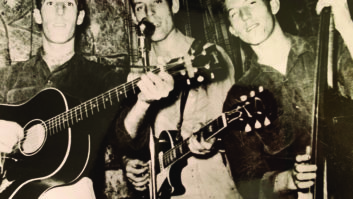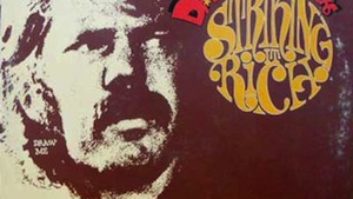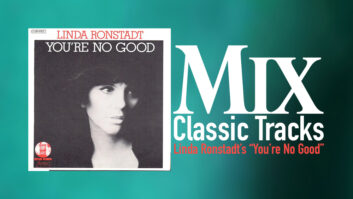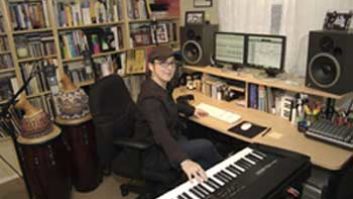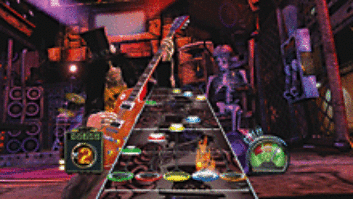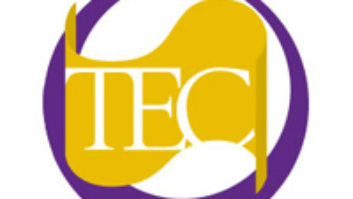Once again finding himself traversing the U.S. at FOH with the Rolling Stones, Irishman Robbie McGrath is somewhat bemused by America’s post-9/11 preoccupation with security. “I grew up with terrorism,” the 48-year-old native Dubliner and one-time Belfast University student says. “So I have a much calmer attitude toward all of the things going on in the world today. I can smell danger anywhere; it’s in my genes.”
McGrath’s sang-froid under trying circumstances and his sixth sense for trouble serve him equally well in both his personal and professional lives. On this, the Stones’ 2K2/2K3 Licks world tour, he relies upon his unflappable internal cool and normally heightened awareness to guide him over the road’s rough spots, especially those found at the beginning of the journey, when all was new and chaos seemed destined to reign.
“This tour was a bit difficult at first,” he confides just prior to a date in L.A., his voice slicing the air with a buoyant brogue, “because we found ourselves dealing with three different types of venues at each stop: stadiums, arenas and theaters. Obviously, the same gear had to do it all, and road cases were going every which way. It initially seemed like an accident looking for a place to happen, but we grabbed on with both hands, and, fortunately, nothing went drastically wrong.”
Now closing in on its fifth month out, the Licks tour has settled into its own highly choreographed pace and runs with the smooth, unerring precision of a Rolex Cosmograph Daytona. Standing tall behind a pair of Midas XL4 consoles (one for the main stage, one for a B stage in arenas and stadiums), McGrath rides herd over an articulate, high-horsepower rig supplied for the typically extravagant Stones event by Des Plaines, Ill.-based db Sound. Based around an assortment of Electro-Voice X-line and Xlc line array components, the system was carefully crafted to meet the demands of production manager Jake Berry, the man behind past Stones forays, as well as recent U2, Cher and Tina Turner tours.
“The basic criteria we had to meet with this system revolved around how much space it would take up on the trucks, how fast it could be taken up and down, how much it weighed, the amount of real estate it occupied in the air and its capability to cover every square inch of any venue,” db Sound’s Harry Witz explains. “Beyond that, we also had to have the flexibility to quickly set up in an arena or stadium one day and a theater the next.”
SHE COMES IN COLORS
To properly facilitate routing of the system components to their multiple destinations in each city, Witz and company devised a straightforward color-coding scheme. Anything marked with a green label is for stadiums only. Items wearing an orange label are for arenas, and white designates theaters. In some instances, multiple labels appear on the same piece of inventory, meaning that a specific element is destined for multiple setups. As a further aid to help the crew know what goes where, each label provides more precise details, such as a loudspeaker’s position within a specific section of the one or more hangs it’s destined for.
Power for all of the Licks’ tour P.A. configurations is supplied by E-V P3000 amplifiers, with each amp rack housing its own XTA processor. On one day, an amp rack may be powering a full-range side hang in an arena. On the next, it may be pushing sub cabinets in a stadium or rolling down a ramp into a theater. Regardless of where it winds up, processing configurations can be programmed as needed via a computer link over an RS485 network on-site.
In McGrath’s estimation, line array technology may not be perfect, but the system he’s currently using with the Stones is bringing sound to places that have never heard it before, especially in stadiums. “Even if you’re in one of the back rows in one of these big spaces, the sound is clear and intelligible,” he notes. “The horizontal and vertical dispersion is fantastic, and the phase is more correct than with any conventional rig I’ve used with the band. That said, I wouldn’t say the technology is a cure-all, but you have to look at the big picture. As live sound engineers, we shouldn’t be out there wanking off like we’re creating an album we’ll all have to listen to for the rest of our lives. We’re doing a two- or three-hour show. During that time, we have to bring as much of the sound as we can to as many of the people as we can. Sure, there are things inherent in line arrays I would let go of along the way to reaching that goal, but, overall, systems like this bring a hell of a lot to the table in terms of horsepower, efficiency, size and manpower needs.”
HEART OF STONE
For McGrath, mixing the Stones is considerably more than just a job. “It’s like owning land,” he says. “You have a tremendous responsibility on your hands. When you own property, you have to take care of it — don’t cut down all of the trees and piss in the rivers. Mixing the Stones is the same. It’s an honor to be asked to look after music like this, so my job is to concentrate on what’s really there and keep it intact for the audience. Keith’s guitar sound has developed and evolved over the years, and it’s not based upon effects. He is the ultimate figure of a man with a guitar slung around his neck, and when he plays, every fiber of his body plays through that instrument. If you’re thinking about putting anything on him in the way of processing, you had better be pretty careful, because there is a hell of a lot of organic energy coming at you in every sense of the word. You can’t use technology to change the Rolling Stones anyway, they are totally unique in that sense. As a unit, they are perfect, warts and all, if that makes any sense. Regardless of the huge lighting systems and sound systems you put around them, they are still the nucleus of the show.”
Despite the presence of a formidable amount of outboard gear at FOH, McGrath uses little — if any — processing on Keith Richards’ guitar. The same holds true at Charlie Watts’ drum kit, where mics are left open for the most part, there is no compression, and the only gates are on toms to govern overtones. For Mick Jagger’s vocals, a tiny bit of compression is added along with some straightforward reverb according to a recipe based on the notion that “the character of his voice makes anything else unnecessary.”
Faced with the same three-different-venues-in-the-same-tour dilemma as the rest of the crew, Licks monitor maven Chris Wade-Evans (or “Wevans” as he’s more commonly known) took stock of the situation and sought out a console that could manage the larger needs of the A stage in both stadiums and arenas, as well as the smaller B stage and theaters within the same architecture. Ultimately settling on an R-Type Cadac design that packs the power of four 24-slot frames into a sprawling desk measuring 12 feet in length, Wevans’ console utilizes three frames for input channels and one for all of the outputs and VCAs. As on the last tour, Wevans specified Firehouse wedges, and for those ready to use in-ear monitors — Mick Jagger among them — he chose Shure’s PSM 600 IEM systems.
CAN’T YOU HEAR ME KNOCKING
“For me, the PSM 600s sound more natural than other newer, competitive offerings,” explains Wevans. “Mick started with the system for the B stage in stadiums, but now he’s taken to using it sometimes for arenas on both the main and B stages. The Cadac is a very clean-sounding board. It has a bit of automation on the end; I use it just so I don’t have to go reaching for solos from the outer reaches. I ordered this desk with slightly more inputs than I used last time out, just in the event that I needed more mixes for odd stadium sidefills and things like that. I also originally planned to duplicate the vocal and main drum channels so that if the band needed radically different mixes in arenas and stadiums, they could be accommodated. It has actually turned out, however, that the mixes stay pretty constant between the two.”
Upon the completion of a February 2 date in San Jose at the HP Pavilion, the Licks tour will close in the U.S. and chart a path for Europe and the rest of the world. “You can talk about it; you can try to explain it, but until you live it, you’ll never really know,” Harry Witz says of the experience of bringing sound to the World’s Greatest Rock Band. “The magnitude, the intensity…it all puts you under a microscope with the whole world watching and listening. Sometimes it hurts, but when you hear the chords of a tune like “Start Me Up” cut evenly across every seat in a cheering house, the rewards clearly outweigh the pain.”
Gregory A. DeTogne, based in Chicago, is a regular contributor to Mix.
